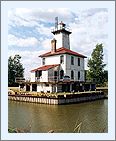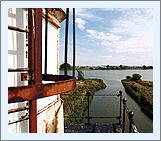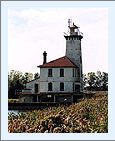|
Historical Information

The Army Corps of Engineers arrived in the Saginaw River in 1867 to begin dredging a 95' wide
by 13' deep channel through the bar at the river mouth in order to open the
river to larger vessels. With their completion of the
improved channel in 1869, the Saginaw Bay Lighthouse which had been in
operation since September 1831 was no longer positioned to
adequately to mark the modified river entrance, and the Lighthouse Board
recommended to Congress that an appropriation of $12,000 be made for the
construction of a set of range lights on the west bank of the river to
guide vessels directly into the new river entry.
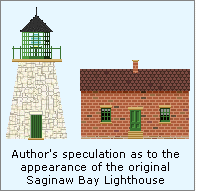 On investigation, it was determined
that the optimal location for the new front range light was at a point
off the river bank approximately 800 feet to the east of the old light,
and that the taller rear range light would need to be constructed inland
some 2,330 feet upstream to the southwest. Negotiations began for
obtaining clear title to the necessary land for the new structures,
however after three years of wrangling with the current owners without
success, the appropriation remained unexpended and reverted back to the
Treasury Department on June 30, 1871, forcing the Board to request a new
appropriation for construction of the ranges. On investigation, it was determined
that the optimal location for the new front range light was at a point
off the river bank approximately 800 feet to the east of the old light,
and that the taller rear range light would need to be constructed inland
some 2,330 feet upstream to the southwest. Negotiations began for
obtaining clear title to the necessary land for the new structures,
however after three years of wrangling with the current owners without
success, the appropriation remained unexpended and reverted back to the
Treasury Department on June 30, 1871, forcing the Board to request a new
appropriation for construction of the ranges.
In the years since the original
appropriation, it had become clear that both the costs of construction
and the purchase of land for the new range lights were going to be
considerably higher than originally estimated, and Eleventh District
Engineer Major Godfrey Weitzel requested a revised appropriation of
$23,000 for the project in his annual report for 1874. That following
year, Julia Brawn remarried, and her new husband George Way moved into
the lighthouse with her while she continued to serve as Keeper. That
same year, Congress appropriated the necessary funds for the
construction of the new range lights, however with continuing problems
experienced in obtaining clear title to the land unsettled until 1876,
work did not begin on the lights until the opening of the season of
navigation in May of that year.
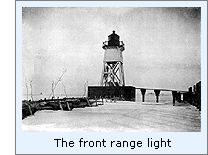 The Front Range Light was constructed
atop a square timber crib just off the western river bank, and took the
form of a 34 foot tall white painted pyramid timber frame structure
similar in design to that being used for pierhead beacons throughout the
district at the time. With its upper half sheathed, a small enclosed
room was thus created beneath the gallery for the storage of oil and
supplies, and in which the Keeper could seek shelter while tending the
light during inclement weather conditions. The gallery was surrounded
with an iron safety railing and capped with a prefabricated octagonal
cast iron lantern. Seated atop a cast iron pedestal within the lantern,
the Light's sparkling new fixed white Sixth Order Fresnel lens sat at a
focal plane of 37 feet, sending its light 8 ½ miles out into the bay. The Front Range Light was constructed
atop a square timber crib just off the western river bank, and took the
form of a 34 foot tall white painted pyramid timber frame structure
similar in design to that being used for pierhead beacons throughout the
district at the time. With its upper half sheathed, a small enclosed
room was thus created beneath the gallery for the storage of oil and
supplies, and in which the Keeper could seek shelter while tending the
light during inclement weather conditions. The gallery was surrounded
with an iron safety railing and capped with a prefabricated octagonal
cast iron lantern. Seated atop a cast iron pedestal within the lantern,
the Light's sparkling new fixed white Sixth Order Fresnel lens sat at a
focal plane of 37 feet, sending its light 8 ½ miles out into the bay.
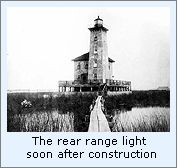 Eleventh District Engineer Major
Godfrey Weitzel's design for the combined rear range tower and dwelling
was unique. Consisting of a large elevated concrete base supporting a
combined brick dwelling and tower, the swampy ground in the chosen site
first required the driving of timber piles deep into the ground to
provide a solid foundation on which timber forms for the concrete base
could be erected and filled. Atop this concrete foundation, a square
two-story Cream City brick keeper's dwelling 26' 6" in plan was
constructed. Integrated into the northwest corner of the dwelling, a
tapered 53' tall square tower with double walls housed a set of
prefabricated cast iron spiral stairs. Winding from the cellar to the
lantern, these stairs also serving as the only means of access to the
first and second floors by way of landings on each floor, each outfitted
with tightly fitting arch-topped iron doors designed to stem the spread
of fire between floors. A timber deck supported by timber columns
encircled the dwelling at the first floor level, providing easy and dry
access to all sides of the structure. The living quarters consisted of a
kitchen, parlor and oil storage room on the first floor, and three
bedrooms above. The tower was capped with a square iron gallery,
supported by five cast iron corbels on each of its four sides. An
octagonal cast iron lantern was installed at its center, with a fixed
white Fourth Order Fresnel lens placed at a focal plane of 61 feet. Eleventh District Engineer Major
Godfrey Weitzel's design for the combined rear range tower and dwelling
was unique. Consisting of a large elevated concrete base supporting a
combined brick dwelling and tower, the swampy ground in the chosen site
first required the driving of timber piles deep into the ground to
provide a solid foundation on which timber forms for the concrete base
could be erected and filled. Atop this concrete foundation, a square
two-story Cream City brick keeper's dwelling 26' 6" in plan was
constructed. Integrated into the northwest corner of the dwelling, a
tapered 53' tall square tower with double walls housed a set of
prefabricated cast iron spiral stairs. Winding from the cellar to the
lantern, these stairs also serving as the only means of access to the
first and second floors by way of landings on each floor, each outfitted
with tightly fitting arch-topped iron doors designed to stem the spread
of fire between floors. A timber deck supported by timber columns
encircled the dwelling at the first floor level, providing easy and dry
access to all sides of the structure. The living quarters consisted of a
kitchen, parlor and oil storage room on the first floor, and three
bedrooms above. The tower was capped with a square iron gallery,
supported by five cast iron corbels on each of its four sides. An
octagonal cast iron lantern was installed at its center, with a fixed
white Fourth Order Fresnel lens placed at a focal plane of 61 feet.
Julia, her husband George and her now
sixteen year old son Dewitt moved into the new dwelling in the rear
range, and exhibited both new lights for the first time on the night of
September 15, 1876. With the establishment of the new ranges, the tower
of the old Saginaw Bay Light no longer served any purpose and was
demolished in order to prevent any confusion to mariners entering the
river. However, the old dwelling was left standing, likely as a dwelling
for an Assistant Keeper should one be deemed necessary to tend the Front
Range. The need for an Assistant to help tend the two lights of the
range was validated on September 11 of the following year, when George
Way was appointed to the position of Acting Keeper, and Julia
simultaneously demoted to the position of Assistant. The pair continued
to tend the light together until 1882, when the Eleventh District office
in Detroit eliminated the position of Assistant Keeper at the station,
and George took over full official responsibility for both the front and
rear ranges. Whether the District office undertook this change in an
attempt to pressure George and Julia into resigning, or as an
underhanded attempt to reduce costs is undocumented. However, it is
likely that some plan was afoot, since on George's death on February 10,
1883, Julia disappeared from lighthouse service and the keeper roster at
the station was again increased to include both a Keeper and Assistant.
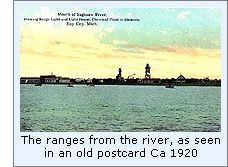 Charlton Leonidus, the new Assistant
Keeper arrived at the station on May 25, 1883 and was joined by the new
Head Keeper Edward Buzzard on October 16 of that same year. One month
after Buzzard's arrival, Leonidus resigned his position, and Buzzard's
wife Nellie took over as Assistant. However, the couple were evidently
ill-suited to the rigors of lighthouse keeping as they both
simultaneously resigned their respective positions after only three
years of service at the station on June 3, 1886. The Buzzard's were the
last husband and wife team to serve the Ranges, and thereafter Keepers
assigned to the station lived in and tended the Rear Range Light, while
their Assistants tended the Front Range and took up residence in the old
brick dwelling that originally served the old Saginaw Bay Light. Charlton Leonidus, the new Assistant
Keeper arrived at the station on May 25, 1883 and was joined by the new
Head Keeper Edward Buzzard on October 16 of that same year. One month
after Buzzard's arrival, Leonidus resigned his position, and Buzzard's
wife Nellie took over as Assistant. However, the couple were evidently
ill-suited to the rigors of lighthouse keeping as they both
simultaneously resigned their respective positions after only three
years of service at the station on June 3, 1886. The Buzzard's were the
last husband and wife team to serve the Ranges, and thereafter Keepers
assigned to the station lived in and tended the Rear Range Light, while
their Assistants tended the Front Range and took up residence in the old
brick dwelling that originally served the old Saginaw Bay Light.
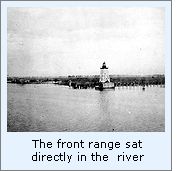 By virtue of its location offshore in
the river, the timber crib of the Front Range deteriorated considerably
as a result of its exposure to constant wave action from passing vessels
and ice grinding during the winter months. To rectify the problem,
significant repairs were undertaken on the crib over 1889 and 1890.
While the Rear Range's location on land some distance from the river
bank eliminated the effects of such wave action on the structure itself,
the banks of the channel from the river to the Light was beginning to
deteriorate and threatened to undermine the structure's foundation. To
this end, a number of rotting pilings were replaced and steel sheeting
installed as a protection against further erosion in the area around the
tower. With population growth in the area upstream from the range in the
early nineties, in increasing number of lights were becoming visible
during darkness. To eliminate potential confusion, the characteristic of
the Rear Range Light was changed from fixed white to fixed red on the
night of June 15, 1891. By virtue of its location offshore in
the river, the timber crib of the Front Range deteriorated considerably
as a result of its exposure to constant wave action from passing vessels
and ice grinding during the winter months. To rectify the problem,
significant repairs were undertaken on the crib over 1889 and 1890.
While the Rear Range's location on land some distance from the river
bank eliminated the effects of such wave action on the structure itself,
the banks of the channel from the river to the Light was beginning to
deteriorate and threatened to undermine the structure's foundation. To
this end, a number of rotting pilings were replaced and steel sheeting
installed as a protection against further erosion in the area around the
tower. With population growth in the area upstream from the range in the
early nineties, in increasing number of lights were becoming visible
during darkness. To eliminate potential confusion, the characteristic of
the Rear Range Light was changed from fixed white to fixed red on the
night of June 15, 1891.
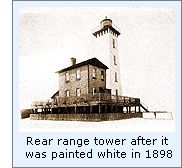 In the mid nineties, waves, ice
damage and rot continued to plague the Front Range, and a work crew
arrived in 1896 to replace ten layers of the timber support crib. Before
leaving, the crew also erected a 625-foot long elevated plank walkway
over swampy ground between the Front and Rear Ranges to make passage
easier for the keepers. After complaints were heard from maritime
interests that the yellowish-gray coloration of the Cream City brick
Rear Range tower was indistinguishable from the sky in overcast
conditions, the tower was given a coat of bright white paint in 1898.
Also in this year it was determined that a large portion of the original
Saginaw Bay Lighthouse reservation was no longer necessary for
lighthouse purposes, and was sold at auction for $1,500 on May 24. In the mid nineties, waves, ice
damage and rot continued to plague the Front Range, and a work crew
arrived in 1896 to replace ten layers of the timber support crib. Before
leaving, the crew also erected a 625-foot long elevated plank walkway
over swampy ground between the Front and Rear Ranges to make passage
easier for the keepers. After complaints were heard from maritime
interests that the yellowish-gray coloration of the Cream City brick
Rear Range tower was indistinguishable from the sky in overcast
conditions, the tower was given a coat of bright white paint in 1898.
Also in this year it was determined that a large portion of the original
Saginaw Bay Lighthouse reservation was no longer necessary for
lighthouse purposes, and was sold at auction for $1,500 on May 24.
With the dawning of the new century,
the old Assistant Keeper's dwelling at the Front Range was sixty years
old, and in dire need of repair. While the kitchen addition recommended
by Henry B Miller in 1850 had been built over the intervening years, the
walls of the structure were plagued by moisture and were beginning to
deteriorate. While complete replacement of the structure was preferred,
the west wall was completely replaced as a least cost measure in 1901,
along with a re-grading of the grounds and the construction of a plank
walkway from the dwelling to the Front Range. At the rear range,
moisture was also taking its toll, with the soft Cream City brick found
to be spalling badly as a result of moisture within the bricks freezing
during the winter. To correct the problem, all badly spalled bricks were
replaced, mortar re-pointed, and the entire structure given a half-inch
thick coating of Portland cement to protect the soft brick surface
against further deterioration.
 Funds were finally appropriated for the
replacement of the decrepit Assistant Keeper's dwelling in 1904, with
plans for the two story structure approved by District Engineer Major
James G. Warren on November 15, 1904. A contract was awarded for the
work, and the work crew arrived with materials to begin construction in
May 1905. That same season a crew was dispatched from the Detroit Depot
to construct a 515 foot long embankment from the Front Range to the
shore and to rebuild the concrete foundation of the Rear Range which had
also been found to be deteriorating as a result of moisture penetration.
Work on both projects continued through the remainder of the year until
the close of the shipping season when conditions became too frigid to
continue the work. Work resumed the following spring, with both projects
being brought to completion that summer. Funds were finally appropriated for the
replacement of the decrepit Assistant Keeper's dwelling in 1904, with
plans for the two story structure approved by District Engineer Major
James G. Warren on November 15, 1904. A contract was awarded for the
work, and the work crew arrived with materials to begin construction in
May 1905. That same season a crew was dispatched from the Detroit Depot
to construct a 515 foot long embankment from the Front Range to the
shore and to rebuild the concrete foundation of the Rear Range which had
also been found to be deteriorating as a result of moisture penetration.
Work on both projects continued through the remainder of the year until
the close of the shipping season when conditions became too frigid to
continue the work. Work resumed the following spring, with both projects
being brought to completion that summer.
In 1915, it finally became clear that
the ongoing cost of maintaining the wooden crib beneath the Front Range
Light was excessive, and plans were put in place to replace the crib
with a more permanent concrete pier, and to replace the wooden tower
itself with a skeletal steel structure. Simultaneous with this change,
it was also decided to electrify both the Front and Rear Ranges by
tapping into the city electrical supply, allowing the replacement of the
labor intensive kerosene lamps with 100-watt incandescent electric lamps
equipped with automatic bulb changers. Work on the new concrete pier at
the Front Range began that summer, and on completion a new black painted
open-frame skeletal steel tower was erected atop the pier. Capped with a
300 mm lens at a focal plane of 39 feet, the tower was outfitted with an
elliptical white slatted daymark to increase visibility of the structure
during daylight hours. Work on both the dwelling and Front Range tower
was completed by late fall, with the new electric lights in both ranges
displayed for the first time on the night of November 28. With
electrification, the nightly workload at the station decreased
dramatically, and the position of Assistant Keeper was again abolished,
this time never to be reinstated.
Also considered a maintenance headache
due to the effects of constant moisture, the wooden deck, steps and
picket fence around the main floor of the Rear Range were replaced with
a concrete deck supported by reinforced concrete columns in 1919, and
the edge of the deck outfitted with a tubular cast iron safety railing.
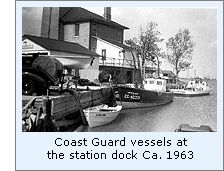 With the transfer of responsibility of
the nation's aids to Navigation to the Cost Guard in 1939, the rear
range Light became the main Cost Guard station for the Saginaw River,
and by 1954, the illumination of the Rear Range Light was changed to an
electrically powered locomotive reflector of 45,000 candlepower with a
visible range of 15 miles. While by this time the station had been
equipped with both telephone and radio telephone equipment, the building
had never been connected to the city water system, and the Coast Guard
crew was forced to transport all their water needs from town in a
trailer-mounted 300 gallon tank. With the transfer of responsibility of
the nation's aids to Navigation to the Cost Guard in 1939, the rear
range Light became the main Cost Guard station for the Saginaw River,
and by 1954, the illumination of the Rear Range Light was changed to an
electrically powered locomotive reflector of 45,000 candlepower with a
visible range of 15 miles. While by this time the station had been
equipped with both telephone and radio telephone equipment, the building
had never been connected to the city water system, and the Coast Guard
crew was forced to transport all their water needs from town in a
trailer-mounted 300 gallon tank.
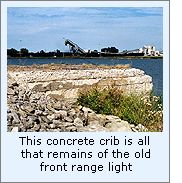 With the dredging of an enlarged
channel extending eight miles into Saginaw Bay to allow larger
freighters to enter the river during the early 1960's, the Ranges no
longer served to mark the entrance of the relocated channel, and plans
were put in place to construct a new set of steel ranges to mark the
channel. With the construction of these mew towers in the early sixties,
the lights in the old ranges were permanently discontinued. With the old
1876 Rear Range tower and dwelling still serving as the Coast Guard
Station, the old 1915 front range was torn down, leaving only its
concrete pier standing at the river's edge, leaving no hint of its
former purpose. With the dredging of an enlarged
channel extending eight miles into Saginaw Bay to allow larger
freighters to enter the river during the early 1960's, the Ranges no
longer served to mark the entrance of the relocated channel, and plans
were put in place to construct a new set of steel ranges to mark the
channel. With the construction of these mew towers in the early sixties,
the lights in the old ranges were permanently discontinued. With the old
1876 Rear Range tower and dwelling still serving as the Coast Guard
Station, the old 1915 front range was torn down, leaving only its
concrete pier standing at the river's edge, leaving no hint of its
former purpose.
With an increase in the volume of
pleasure boaters moving in and out of the Saginaw during the summer
season, the size of the crew assigned to Station Saginaw was increased,
and it soon became evident that cramped quarters in the old dwelling and
the small dock alongside the structure were wholly insufficient for the
purpose. At the close of the 1970's, a site for a new station was
selected across the river and slightly upstream from the old Rear Range
in Essexville, with construction of the facility completed in December
of 1980. The crew moved their vessels, furniture and belongings across
the river, and abandoned the old rear Range structure to the elements.
The venerable building slowly deteriorated for nine years until Dow
Chemical, which owned all of the surrounding property on that side of
the river, purchased the structure and reservation in 1989.
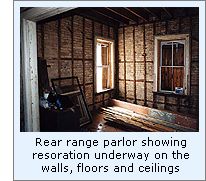 Dow boarded up the windows and doors in
an attempt to keep vandals, bats and birds at bay, and undertook a study
in order to identify the predicted costs associated with restoration.
With nothing further being done on the building, the Board of Directors
of the Saginaw River Maritime Historical Society approached Dow Chemical
in the fall of 1999 to see if they could be of any assistance with the
project. As a result, an agreement was arranged whereby SRMHS would
serve as stewards of the building, providing labor and management, and
assisting Dow in the fund raising process. Dow boarded up the windows and doors in
an attempt to keep vandals, bats and birds at bay, and undertook a study
in order to identify the predicted costs associated with restoration.
With nothing further being done on the building, the Board of Directors
of the Saginaw River Maritime Historical Society approached Dow Chemical
in the fall of 1999 to see if they could be of any assistance with the
project. As a result, an agreement was arranged whereby SRMHS would
serve as stewards of the building, providing labor and management, and
assisting Dow in the fund raising process.
Already under this agreement, members
of the SRMHS have completely replaced the roof of the dwelling, all
window glass has been replaced and the lighthouse grounds have been
cleared and are now maintained in a manicured condition. Additionally,
all interior plaster and lath has been removed to expose structural
problems which will now be rectified. While the lighthouse property is
currently only open to Society members during scheduled work session,
the SRMHS hopes eventually to restore the building to a condition in
which it can serve as a maritime museum, and looks forward to a day when
it can be opened it to the public, so the world can enjoy the historical
structure.

Keepers of this
Light

Click here
to see a complete listing of all Saginaw River Light keepers compiled by
Phyllis L. Tag of Great Lakes Lighthouse Research.

Seeing this Light

On our first trip to visit this Light, we knew of this lighthouse's existence, but had dim hopes of actually
being able to get a photograph of the structure since it is situated on
the shore of the Saginaw River in the middle of a huge marshy area owned
by the Dow Chemical Company, and completely surrounded by Dow Chemical
property. Assuming that our best opportunity would be from across the River in
Essexville, we started driving towards Saginaw Bay, turning onto every
road that lead towards the River. It soon became clear that there was little hope of any public access to
the River along the Eastern shore, since the shore was crammed with
industry and junkyards. We finally caught a glimpse of the structure
between the trees at the new Coast Guard station, and could see that we
needed to head approximately a half mile further towards the Bay in
order to be opposite the light. Continuing down an industrial road towards the Bay, our hearts dropped
when the road terminated at a guard shack at the perimeter the Consumers
Power generating station. Undaunted, I parked the truck, and walked up
to the guard shack, explained my mission, and asked the guard if he knew
of any place where it might be possible to find a public access to
the shore to take some photographs of the old lighthouse. The guard
explained that Consumers Power maintains the complex as a wildlife
sanctuary, and that he would grant us access to a foot trail that led
down to the edge of the river, where we might be able to catch a glimpse
of the light.
Signing-in, and parking our truck, we made the walk to the shore, and
pressed our way through some of the tallest swamp grasses we have ever
seen. Bursting out of the grass, and onto the river bank, the abandoned
lighthouse could be seen across the river. We were fortunate that
weather conditions had been extremely dry for the past year, since it
was plain that grasses and the area from which we took the shot would
normally have been submerged and impassable. That 500mm lens we
purchased in February really helped-out this evening!
On our second trip, we arranged to meet
two members of the SRMHS at the Light for a tour of the entire station,
during which we took most of the photographs shown on this page.

Finding this Light

 The
Saginaw River Rear Range Lighthouse is located in on private Dow
Chemical property in Bangor Township on the west bank of the Saginaw
River (near where the river meets the Saginaw Bay) just north of Bay
City, Michigan. While the Saginaw River Marine Historical Society is working
with Dow Chemical to restore the structure, access to the light is
presently restricted to members of the Society at this time. The
Saginaw River Rear Range Lighthouse is located in on private Dow
Chemical property in Bangor Township on the west bank of the Saginaw
River (near where the river meets the Saginaw Bay) just north of Bay
City, Michigan. While the Saginaw River Marine Historical Society is working
with Dow Chemical to restore the structure, access to the light is
presently restricted to members of the Society at this time.
To be frank, we were completely lost when we came to guard house at the end of the
road when we photographed the Light. Our only suggestion would be that you look for the Consumers Power
Plant, and take it from there!

Contact
information

Saginaw River Marine Historical Society
Lighthouse Restoration Project
P.O. Box 2051
Bay City, MI. 48707-2051

Reference Sources

Journals of the US Senate, 1836 & 1837
Journals of the US House of Representatives, 1835-1837
Annual reports of the Fifth Auditor of the Treasury, 1838 & 1850
Annual reports of the Lighthouse Board, various, 1853 - 1909
Great Lakes Light Lists, various, 1853 - 1958
The Lumber Region of Michigan. North American Review, July, 1868
Illustrated History of Bay County, 1888
History of Saginaw County, Michigan. James Cook Mills, 1898.
Annual reports of the Commissioner of Lighthouses, 1909 - 1939
Annual reports of the Lake Carrier's Association, various, 1915 - 1930
The Long Ships Passing, Walter Havighurst, 1943
Lighthouse nears 1st century , Detroit News, May 21, 1972
Northern Lights, Charles K. Hyde
Keeper listings for this light appear courtesy of Great
Lakes Lighthouse Research
|

